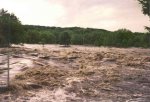alsih2o
First Post
Below are 3 examples of places where it is hard to move.
1. A wet expanse of loose sand with rocks jutting out
2. Just rocks, with large gaps
3. 3 feet of rushing water
As a DM, what kinds of rules and hinderances would you place on a player for each surface? I am not looking for the Rules As Written. I would liek to know what you woudl rule if your players ported in and started running. What about their mounts? How much do oyu slow down players for environmental hazards?
The movement rules seem non-sacred cow-ish, and I think we all play with them a bit more than somethign like HP or AC, and I am not asking for the RAW. So, I thought this wasn't a Rules Forum question. Apologies ot the mods if I am mistaken.
1. A wet expanse of loose sand with rocks jutting out
2. Just rocks, with large gaps
3. 3 feet of rushing water
As a DM, what kinds of rules and hinderances would you place on a player for each surface? I am not looking for the Rules As Written. I would liek to know what you woudl rule if your players ported in and started running. What about their mounts? How much do oyu slow down players for environmental hazards?
The movement rules seem non-sacred cow-ish, and I think we all play with them a bit more than somethign like HP or AC, and I am not asking for the RAW. So, I thought this wasn't a Rules Forum question. Apologies ot the mods if I am mistaken.
Attachments
Last edited:






 Medium characters can move 5' as a full round action and must make a DC 12 strength check each round or "fall down". Small and smaller characters or those who "fall down" must make swim checks DC 20 or be swept away. Medium creatures can "stand up" again with a DC 15 Str check.
Medium characters can move 5' as a full round action and must make a DC 12 strength check each round or "fall down". Small and smaller characters or those who "fall down" must make swim checks DC 20 or be swept away. Medium creatures can "stand up" again with a DC 15 Str check.